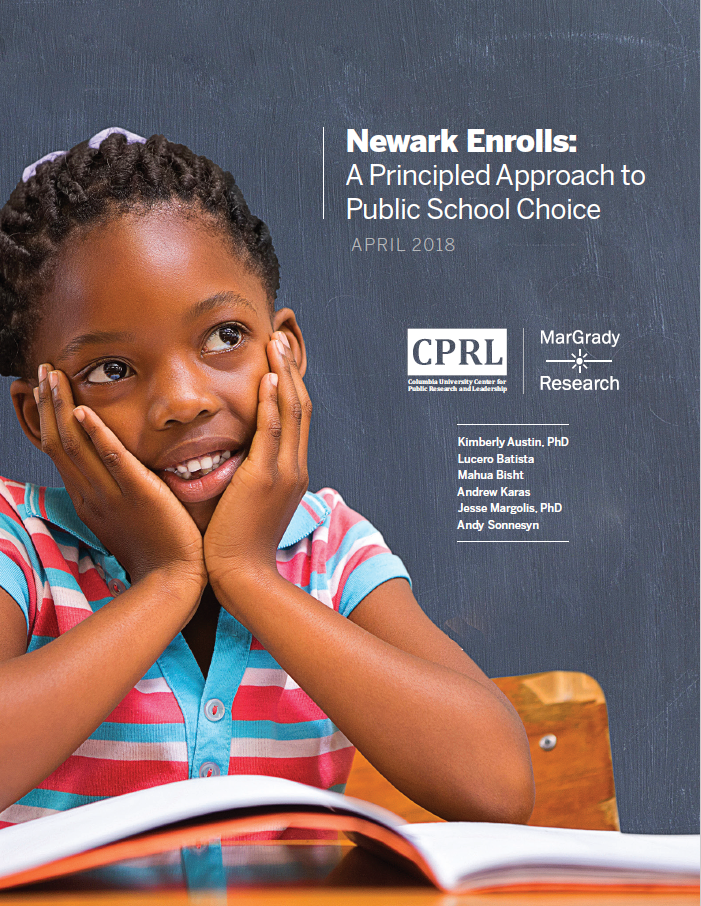Kimberly Austin, Lucero Batista, Mahua Bisht, Andrew Karas, Jesse Margolis, and Andy Sonnesyn
April 2018
Background
Newark Public Schools (NPS), in partnership with most of the city’s charter schools, developed a universal enrollment system in 2013 that went into operation the following year. Like a growing number of cities, Newark adopted universal enrollment as a way to lessen the impact of resource and other inequalities on families’ ability to exercise school choice. Newark’s system, called Newark Enrolls, was to be guided by seven principles: choice, access, community, equity, reliability, ease, and transparency. With four enrollment cycles completed and over 36,000 students placed, the Newark community is now in a position to assess the impact of Newark Enrolls. In this report, MarGrady Research and the Center for Public Research and Leadership (CPRL) at Columbia University use quantitative and qualitative data to examine enrollment patterns and practices under the universal enrollment system.
Findings
Following a well-defined set of principles and implementing a transparent set of citywide policies and practices, Newark Enrolls has increased school choice while respecting the importance of community. Families of high-needs students have greater access to high-demand schools, and schools have more reliable data about their incoming students. However, these achievements were not immediate. Many lessons were learned along the way, and there remains room for improvement.
Key findings include:
- Most students who apply through Newark Enrolls are matched to one of their top choices.
- Students who want to attend school in their neighborhood are able to do so. However, as Newark Enrolls has made it easier to apply to schools in other neighborhoods, more families have done so.
- Special education students and those who are eligible for free lunch have greater access to schools that are in high-demand than before Newark Enrolls went into effect. This includes access to popular magnet and charter schools.
- NPS schools now receive more reliable information about student enrollment at the beginning of the year, and the number of ‘no shows’ has declined.
- Since it launched, Newark Enrolls has made the application process easier and more transparent by making publicly available increasing amounts of useful information about schools and enrollment policies.
Figure – Share of Ninth Grade Students Requiring Special Education Services

The figure above shows the share of ninth grade students who require special education services in each of three types of high schools: charter schools, NPS magnet schools, and NPS traditional schools. Prior to Newark Enrolls, the distribution of special education was uneven across these three school types. In 2013-14, for example, 5% of ninth graders at magnet schools required special education services compared to 13% of ninth graders at charter schools and 23% of ninth graders at traditional schools. These percentages changed dramatically with the launch of Newark Enrolls, which provided a priority for special education students. In 2014-15, the percentage of ninth graders in magnet schools who required special education services more than doubled from 5% to 13%. The same percentage in charter schools increased from 13% to 16%, while the percentage in traditional high schools declined. Despite these improvements, there remains inequity in the distribution of special education students. Traditional high schools continue to enroll a higher share of special education students than do charters or magnet schools, and the gap has grown slightly over the last two years.
Media Coverage
Chalkbeat (April 20, 2018) – On high school match day, two-thirds of Newark eighth graders want magnet schools – but far fewer will get them
Chalkbeat (June 18, 2018) -Â Should ‘Newark Enrolls’ be scrapped? A guide to the debate over Newark’s controversial enrollment system
